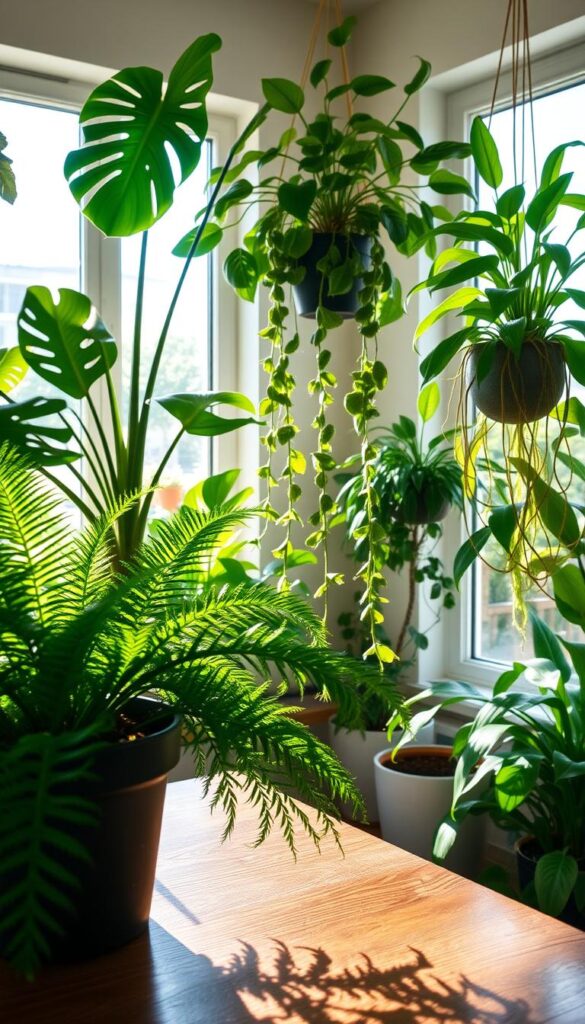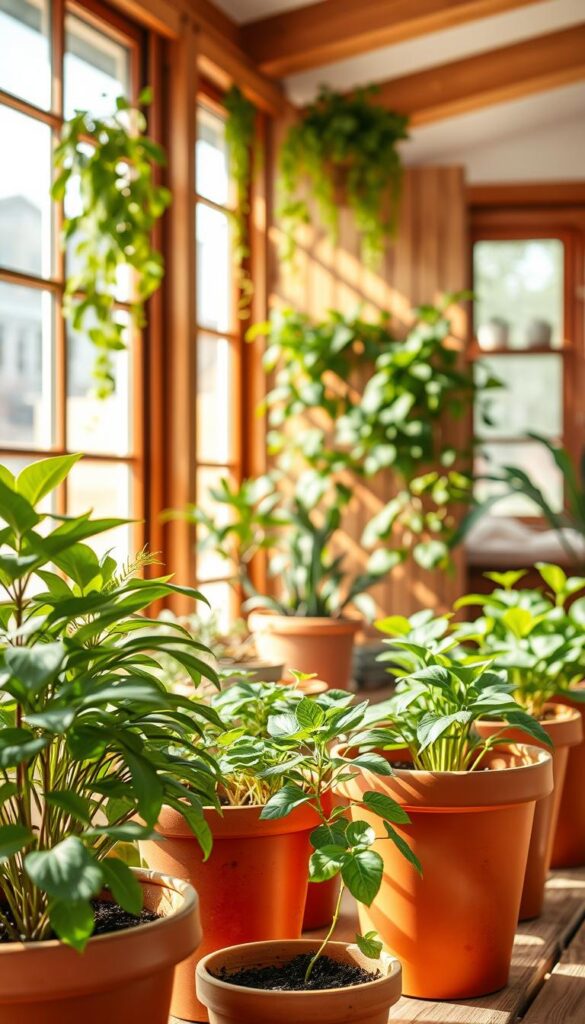As I sit here surrounded by my lush indoor plants, I’m reminded of how these green companions do more than just brighten up a room. They’re tiny warriors fighting against environmental challenges, one leaf at a time. In a world where climate change is reshaping our ecosystems, indoor gardening has become a vital practice—not just for beauty, but for our planet’s health.
Did you know that rising carbon dioxide levels can actually boost plant growth? This phenomenon, known as carbon fertilization, has been shown to increase photosynthesis by up to 12% globally. Plants are adapting by adjusting how they open their stomata, reducing water loss while still absorbing the CO₂ they need to thrive. This delicate balance between water usage, soil nutrients, and plant health is crucial for sustainable indoor gardening.
My journey into indoor gardening began with a small herb garden on my kitchen counter. Over time, I’ve learned how to optimize temperature and light conditions to help my plants flourish. In this article, I’ll share insights on how to create a thriving indoor ecosystem, from managing moisture levels to selecting the right species for your space. Let’s explore how we can grow healthier plants while contributing to a healthier world.
Understanding the Impact of Climate Change on Indoor Plant Health
Indoor plants are more than just decorative elements; they are living organisms adapting to our changing world. As global conditions shift, understanding how these changes affect your plants is crucial for their well-being.
How Elevated CO₂ Levels Influence Photosynthesis
Rising CO₂ levels have a fascinating effect on plants. Between 1982 and 2020, global plant photosynthesis increased by 12%. This phenomenon, known as carbon fertilization, occurs because plants use CO₂ for photosynthesis. With more CO₂ available, plants can produce more energy, leading to healthier growth.
Plants also adapt by partially closing their stomata, reducing water loss by up to 20%. This adaptation helps them thrive in environments with limited water, making them more resilient to droughts.
Effects of Rising Temperatures and Water Stress
While increased CO₂ benefits plants, rising temperatures and water scarcity can stress them. Higher temperatures accelerate plant metabolism, increasing water demand. If water isn’t available, growth slows, and plants may suffer.
Nutrient imbalances can also occur. For instance, excessive CO₂ uptake can lead to nitrogen deficiency, stunting growth. This highlights the need for balanced care to support plant health.
| Factor | Effect on Plants | Impact on Growth |
|---|---|---|
| Increased CO₂ | Boosts photosynthesis, reduces water loss | Enhanced growth, healthier plants |
| Rising Temperatures | Increases water demand, accelerates metabolism | Potential stress, slowed growth if water is scarce |
| Water Stress | Reduces stomatal opening, limits CO₂ intake | Decreased photosynthesis, stunted growth |
Understanding these factors is key to supporting your plants. By adapting care practices, you can help them thrive despite environmental challenges.
Climate Change and Indoor Plant Cultivation: Strategies for Success
As I tend to my indoor plants, I realize how crucial it is to adapt our care practices to the changing environment. Rising temperatures and shifting conditions require mindful adjustments to help our plants thrive.
Adapting Growing Techniques for a Warmer World
One key strategy is modifying watering practices. Plants may need more frequent watering due to higher temperatures, but overwatering can be harmful. Using moisture-retentive potting mixes helps maintain soil health and prevents nutrient depletion.
Lighting is another critical factor. Energy-efficient grow lights can supplement natural light, ensuring plants receive adequate illumination without excessive heat. This balance supports healthy photosynthesis and growth.
| Strategy | Technique | Benefit |
|---|---|---|
| Adjust Watering Practices | Use moisture-retentive potting mixes | Maintains soil health, prevents nutrient depletion |
| Optimize Lighting | Install energy-efficient grow lights | Supports photosynthesis without excess heat |
| Monitor Temperature and Humidity | Use thermometers and hygrometers | Creates optimal growing conditions |
By implementing these strategies, indoor gardeners can create resilient ecosystems that flourish despite environmental challenges. Simple adjustments can lead to significant improvements in plant health and productivity.

Optimizing Growing Conditions Indoors
Creating the perfect environment for your plants is like giving them a little slice of nature indoors. It all starts with the soil. Testing the pH level and nutrient content ensures your plants get exactly what they need. I use a simple DIY kit to check the soil quality regularly. Adding organic matter like compost or well-rotted manure can work wonders for improving soil health.
Water efficiency is another key factor. Overwatering can be harmful, so I monitor soil moisture by sticking my finger into the soil up to the knuckle. If it feels dry, it’s time to water. Using moisture-retentive potting mixes helps maintain the right balance. I also recycle water from pots by collecting excess in a tray and reusing it.
Lighting and temperature go hand in hand. Most plants thrive in temperatures between 65-75°F during the day and slightly cooler at night. I use energy-efficient grow lights to supplement natural light, especially during the winter months. Placing plants near sunny windows but away from direct heat sources creates an ideal setup. By controlling these factors, I’ve noticed a significant boost in plant health and productivity.
Leveraging the Benefits of Indoor Plants for a Healthier Home
Indoor plants are more than just beautiful additions to our homes—they play a vital role in creating a healthier living environment. By naturally purifying the air and promoting oxygen generation, these plants contribute significantly to improving indoor air quality.
Improving Indoor Air Quality Naturally
Common houseplants like spider plants and peace lilies have remarkable air-purifying capabilities. They intercept pollutants such as formaldehyde and benzene, making the air cleaner and healthier to breathe. My indoor garden has been instrumental in reducing indoor air pollution, creating a fresher atmosphere that benefits everyone in the household.
From a scientific perspective, plants absorb carbon dioxide and release oxygen through photosynthesis. This natural process not only enhances air quality but also contributes to a more comfortable living space. While houseplants can’t completely eliminate environmental stressors, they play a modest yet important role in cleaning the air and improving overall well-being.
When choosing plants to maximize air quality benefits, I recommend selecting species known for their efficiency, such as snake plants or Boston ferns. It’s also important to consider the environmental footprint of plant ownership, ensuring sustainable practices that align with a greener lifestyle.
In conclusion, while indoor plants can’t solve all environmental challenges, their benefits are undeniable. By mindfully selecting and caring for our plants, we can enjoy cleaner air and a healthier home, all while contributing to a more sustainable world.
Sustainable Practices in My Indoor Gardening Routine
Sustainability is at the heart of my indoor gardening journey. I believe that nurturing plants goes hand in hand with caring for the environment. By adopting eco-friendly practices, I can help reduce my gardening’s ecological footprint while still enjoying the benefits of lush greenery indoors.
Choosing Eco-Friendly Potting Mixes and Containers
One of the simplest ways to make a positive impact is by selecting sustainable potting mixes. I opt for coconut coir, a biodegradable and renewable alternative to peat, which reduces the environmental strain caused by peat extraction. This choice not only supports healthier plant growth but also aligns with my commitment to preserving natural resources.
Minimizing Waste Through Reuse and Recycling
Plastic pots and containers are common in gardening, but they contribute to waste. I reuse my plastic pots whenever possible and participate in local recycling programs. Many garden centers now offer schemes where you can return old pots for recycling, reducing the amount of plastic that ends up in landfills. Additionally, I repurpose containers from household items, giving them new life in my garden.

By thoughtfully selecting materials and reducing waste, I create a more sustainable indoor garden. These small steps not only benefit the environment but also foster a deeper connection between my plants and the natural world.
Integrating Ecosystem Insights into My Indoor Garden
My indoor garden isn’t just a collection of plants; it’s a micro-ecosystem inspired by the natural world. By studying outdoor ecosystems and global climate trends, I’ve gained valuable insights that enhance my gardening practices.
Learning from Outdoor Research and Global Trends
Research on outdoor ecosystems reveals how plants adapt to environmental changes. For instance, shifting growing seasons and species migration patterns show how nature responds to climate shifts. These observations guide my choices in selecting resilient plant species and adjusting care routines.
Ecosystems provide essential services like nutrient cycling and pest control. Indoors, I mimic these processes by using compost and natural pest deterrents. This approach not only benefits my plants but also supports a healthier environment.
Lessons from natural forests and wetlands influence my plant care. For example, maintaining soil health through organic matter mirrors forest floors, while water management techniques reflect wetland systems. These practices ensure my plants thrive sustainably.
By applying scientific research to my gardening, I’ve made practical adjustments. Monitoring temperature and CO₂ levels, similar to managing a small ecosystem, has improved plant growth. This holistic approach fosters a balanced indoor environment.
Consider the broader ecosystem when planning your indoor garden. Embrace insights from nature to create a resilient and sustainable space that benefits both your home and the planet.
Embracing a Greener Future for My Indoor Plant Journey
As I look ahead to the future of my indoor plant journey, I’m filled with optimism and a renewed commitment to sustainable gardening. The lessons I’ve learned about adapting to environmental changes and embracing eco-friendly practices have been invaluable. By continuously refining my techniques, such as optimizing water use and selecting resilient plant species, I’ve created a thriving indoor ecosystem that not only benefits my home but also contributes to a healthier planet.
I encourage everyone to join me in this greener lifestyle. Simple steps like using energy-efficient lighting and sustainable potting mixes can make a significant difference. Together, we can reduce waste and promote a more sustainable approach to gardening. Let’s embrace eco-conscious choices and work towards a future where indoor plants continue to flourish, improving air quality and enhancing our living spaces.
By integrating sustainable practices into our daily lives, we can create a harmonious balance between our homes and the environment. Let’s take mindful steps today to ensure a healthier tomorrow for both our plants and our planet.
